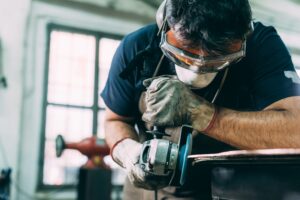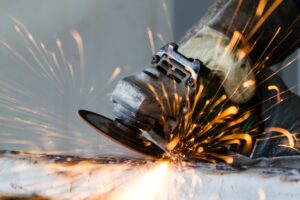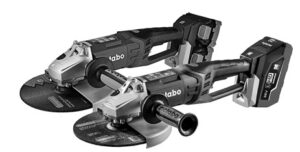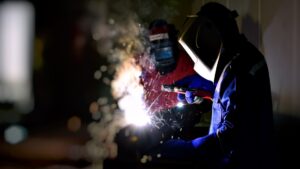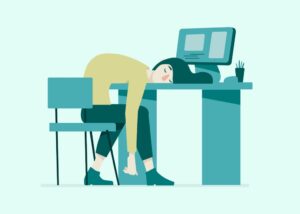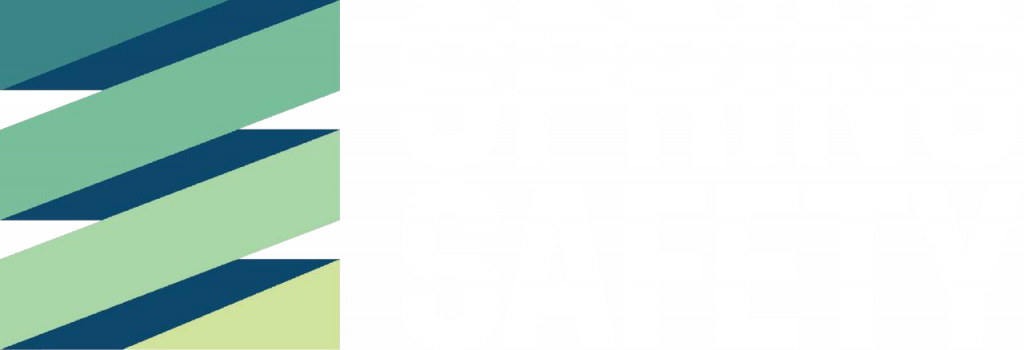Back to Basics: Working Safely With Grinders
Angle grinders, while essential for cutting, grinding, and polishing, are among the most dangerous tools in any workplace. The majority of injuries from these tools involve metal particles lodging in the operator’s eye, but the most serious risks come from kick-back, where the disc is violently thrust back towards the user. Additionally, using cutting discs with angle grinders exposes workers to severe hazards, including the potential for discs to shatter or explode, sending dangerous fragments flying in all directions. Therefore, whenever a safer alternative cutting tool is available, it is advisable to avoid using an angle grinder for cutting tasks. To enhance safety, it’s critical to wear proper PPE, inspect equipment before use, maintain a secure work environment, and always handle the grinder at the correct angle to prevent accidents. Prioritising these safety measures can help mitigate the risks associated with this powerful yet perilous tool.
Major Fines for Fatalities and Serious Injuries Linked to Angle Grinders
Angle grinders are powerful tools, but their misuse can lead to severe consequences, including life-threatening injuries and fatalities. Across Australia, companies have faced significant fines for failing to ensure the safe use of angle grinders in the workplace. These fines highlight the importance of adhering to safety regulations and implementing proper training and supervision. Below are eight instances where businesses were penalised following tragic incidents involving angle grinders:
- LWB Consulting Pty Ltd: A $250,000 fine was imposed after a worker died due to improper training and the removal of the grinder’s guard.
- Proline Steel Pty Ltd: The company faced a $180,000 penalty when an apprentice sustained serious injuries from a grinder kickback caused by a missing guard.
- Roy Hill Holdings Pty Ltd: A fatality resulted in a $200,000 fine for using an incorrect disc and inadequate supervision.
- Hazell Bros Group: The company was fined $170,000 after a worker was killed by a defective disc that shattered during use.
- Diamond Powder Coaters WA: A fatality resulted in a $85,000 fine after an explosion from using an angle grinder to cut into a metal drum.
- All State Demolition Pty Ltd: A $100,000 fine followed an incident where a worker was severely injured due to improper use and lack of safety equipment.
- Greenup Engineering Pty Ltd: The company incurred a $120,000 fine after a worker suffered severe facial injuries from an unguarded grinder.
- Ahern Industrial Services Pty Ltd: A $150,000 fine was issued after a worker was fatally injured due to poor maintenance and safety checks on the grinder.
These cases serve as a reminder to PCUBs that ensuring proper safety procedures and equipment checks are essential when working with angle grinders. Companies that prioritise the safety of their workers will avoid tragic outcomes and the heavy fines that follow.
PCBU – Reduce risk by prohibiting tools
In Western Australia, the use of 9-inch grinders has been restricted by several companies due to the significant safety risks associated with them. These tools have been involved in numerous serious incidents, including fatalities, leading some businesses, particularly in high-risk sectors like construction and mining, to prohibit their use altogether.
For example, Programmed have taken the hard stand, designed risk management strategies that simply don’t tolerate the level of risk associated with 9-inch grinders we “don’t allow 9-inch grinders to be used on our work sites. The ban is due to the high proportion of serious injuries that result from the use of these tools. Common injuries include amputations, serious lacerations and face / eye injuries from shattered cutting and grinding discs.”
Worker – 5 top tips for work safely with grinders
1. Wear Appropriate Personal Protective Equipment (PPE): Ensure that you are wearing the correct PPE, including
- wide vision goggles, or safety glasses and a face shield;
- a hood for extra protection against particles rebounding in a confined space;
- hearing protection, ear muffs;
- safety boots with steel toe caps;
- overalls or other close fitting clothing;
- well-fitting gloves that allow a good grip of the tool; and
- respiratory protection to prevent inhalation of fumes
2. Inspect the Grinder and Discs Before Use: Always check the grinder and the discs for any signs of damage or wear. Make sure that the disc is properly installed and rated for the grinder’s speed.
3. Maintain a Safe Working Environment: Keep the work area clear of any flammable materials and ensure good ventilation. Secure the workpiece to prevent it from moving during operation.
4. Use the Grinder at the Correct Angle: When grinding, hold the grinder at the correct angle to the work surface (typically around 15 to 30 degrees for most applications) to prevent kickback and ensure efficient material removal.
5. Turn Off the Grinder When Not in Use: Always turn off the grinder when not actively grinding and ensure it has come to a complete stop before setting it down.
Consulting Services
If your organisation is seeking guidance on how to improve safety performance and minimise risk, please reach out to our Spring Safety Consultants on 08 9202 6812.
References
Angle grinders | Department of Energy, Mines, Industry Regulation and Safety (commerce.wa.gov.au)
Ndana, Jean . “Working Safely With Grinders: 10 Proven Best Practices.” Prof. Safety 60 (2015): 26–29.
260- Banned Tools – 9 Inch Grinders – Programmed AU | The Power of a Job done Right.

